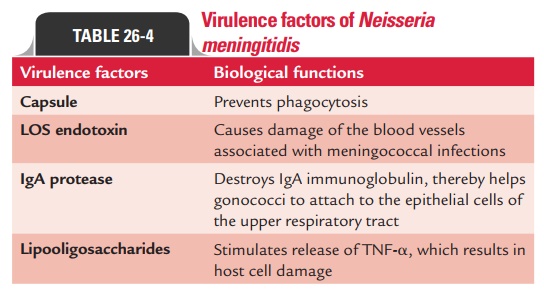Chapter: Microbiology and Immunology: Bacteriology: Neisseria
Pathogenesis and Immunity - Neisseria meningitides
Pathogenesis and Immunity
N. meningitidis colonizes the human nasopharynx, and underspecific conditions, invades the blood stream and then reaches the brain, causing meningitis.
◗ Virulence factors
N. meningitidis has three important virulence factors, which areresponsible for causing disease. These are (a) capsular polysac-charide, (b) LOS endotoxin, and (c) IgA protease (Table 26-4).

Capsular polysaccharide: N. meningitidisis surrounded bya prominent polysaccharide capsule that is antiphagocytic. The capsule is an important virulence factor, which contrib-utes to the virulence by inhibiting phagocytosis. The capsule protects meningococci from destruction by the leukocytes. Inside the phagocytic vesicle of the leukocyte, they survive intracellular death, multiply, and then migrate to subepithe-lial spaces.
LOS endotoxin: LOS endotoxin is present in the outermembrane of N. meningitidis. It is responsible for damage of the blood vessels associated with meningococcal infections. The endotoxin comprises two antigenic determinant compo-nents: (a) a protein component and (b) a carbohydrate compo-nent. The continuous production and release of endotoxin by N. meningitidis cause severe endotoxin reaction, seen in patientswith meningococcal disease.
IgA protease: IgA protease is the other important virulencefactor. The enzyme acts by clearing the secretory IgA, thus help-ing the bacteria to attach to the epithelial cells of the upper respiratory tract.
◗ Pathogenesis of meningitis
Initially, N. meningitidis causes a localized infection by coloniz-ing the nasopharynx. From this site, the meningococci invade the submucosa by circumventing the host defense mecha-nisms and gain access to the central nervous system (CNS). Meningococci reach CNS by the following ways:
1. Invasion of blood stream: This is the most commonmode of spread of meningococci. Once inside the blood stream, the meningococci escape the immune surveillance (e.g., antibodies, complement-mediated bacterial killing, neutrophil phagocytosis) of the host and subsequently reach distant sites including the CNS. The specific mecha-nism by which the meningococci reach the subarachnoid space still remains to be clearly understood.
2. Direct contiguous spread: Meningococci can alsoreach the CNS by direct contiguous spread from naso-pharynx. Inside CNS, the bacteria multiply and survive because host defense mechanisms (such as immuno-globulins, neutrophils, and complement) appear to have limited role in controlling multiplication of the bacte-ria. Uncontrolled multiplication of bacteria continues in the CSF, which subsequently causes a cascade of men-ingeal inflammation. Meningococcal infection of the nasopharynx is usually subclinical. Asymptomatic naso-pharyngeal carriage of meningococci is of short dura-tion and resolves within several weeks. In a few persons, meningococci invade the circulation and cause clinical disease.
◗ Host immunity
The presence of meningococci in the nasopharynx induces a humoral antibody response, and most people acquire immunity to meningococcal disease by age of 20 years. Maternal antibodies provide protection to infants for the first 3–6 months of life. Later, colonization with nonpathogenic meningococci appears to produce cross-reacting, protective antibodies.
Specific IgG antibodies are produced against meningococcal polysaccharides in combination with the complement medi-ate bactericidal activity against the meningococci. Individuals lacking the bactericidal antibodies and those suffering from complement deficiencies—such as C5, C6, C7, or C8 compo-nents of the complement—show increased susceptibility to meningococcal disease.
An episode of meningitis confers group-specific immunity, but a second episode may be caused by another meningococcal serogroup.
Related Topics